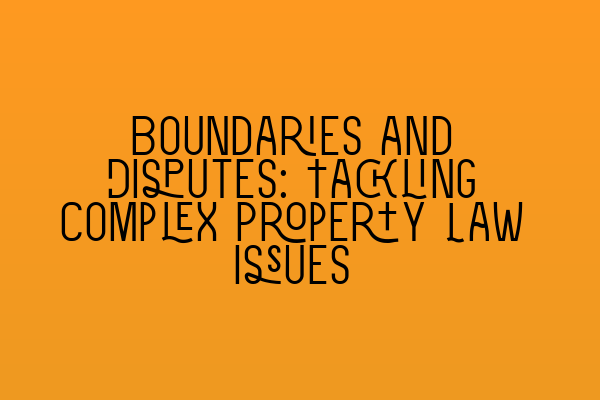Boundaries and Disputes: Tackling Complex Property Law Issues
Introduction:
Property law is a complex and multifaceted area of law that covers a wide range of legal issues. One such issue that frequently arises in property law is boundaries and disputes. Understanding the intricacies of boundaries and how disputes can be tackled is essential for both property owners and legal professionals specializing in property law. In this blog post, we will delve into the complexities of boundary disputes, highlight important legal principles, and provide insights on how to effectively handle these contentious issues.
1. A Primer on Boundaries:
Boundaries are a fundamental concept in property law, serving as the dividing lines between different parcels of land. They give landowners a clear understanding of their rights and responsibilities concerning their property. However, determining the exact location of a boundary can be challenging, leading to disputes between neighboring property owners.
2. Types of Boundary Disputes:
Boundary disputes can arise for various reasons, including differences in interpretation, historical inaccuracies, or changes to the physical landscape. Some common types of boundary disputes include:
a. Encroachment: When structures or improvements, such as fences, buildings, or gardens, extend beyond the boundary line onto an adjoining property.
b. Adverse Possession: When an individual occupies and uses a piece of land belonging to someone else openly and without permission for a specified period, often leading to a claim of legal ownership.
c. Misalignment: When an original survey or boundary plan contains errors or inaccuracies, causing discrepancies and conflicts between neighboring properties.
d. Trespass: When one party enters or uses another person’s property without permission, potentially leading to a dispute over the boundaries.
3. Legal Principles Governing Boundary Disputes:
A solid understanding of the legal principles surrounding boundary disputes is crucial when dealing with these complex property law issues. Some key principles include:
a. Deeds and Title Documents: Deeds and title documents play a significant role in establishing boundaries. Legal professionals must carefully review these documents to determine the extent of a property owner’s rights and responsibilities.
b. Boundary Agreements: Property owners can enter into boundary agreements to resolve disputes amicably. These agreements outline the agreed-upon location of the boundary and are legally binding.
c. The Doctrine of Adverse Possession: Adverse possession allows an individual to claim legal ownership of a piece of land if certain conditions are met, including open and continuous use for a specified period. Legal professionals must consider this doctrine when handling boundary disputes.
4. Effective Strategies for Resolving Boundary Disputes:
Resolving boundary disputes can be a long and challenging process. However, with the right strategies, property owners and legal professionals can navigate these disputes more effectively. Some strategies include:
a. Communication and Negotiation: Encouraging open and constructive communication between parties involved in a boundary dispute can often lead to a mutually acceptable resolution. Mediation or alternative dispute resolution methods can also be explored.
b. Expert Opinion: Consulting experts such as land surveyors or property law specialists can provide valuable insights and guidance in resolving complex boundary disputes.
c. Litigation: In some cases, litigation may be the only option to resolve a boundary dispute. Legal professionals must carefully analyze the evidence, research relevant case law, and present a compelling argument to the court.
Conclusion:
Boundary disputes are a common and challenging aspect of property law. Understanding the intricacies of boundaries and employing effective strategies for dispute resolution are essential for both property owners and legal professionals. By considering the legal principles governing boundaries, exploring amicable resolutions, and, if necessary, pursuing litigation, these complex property law issues can be effectively tackled.
Related Articles:
– Misrepresentation in Contracts: Unveiling Deceptive Practices
– A Closer Look at SQE Contract Law Syllabus
– SQE Contract Law: Analyzing Landmark Cases and Influential Judicial Decisions
– Understanding Contractual Capacity: Rights and Limitations
– Interactive SQE Mock Tests for Contract Law: Test Your Knowledge
